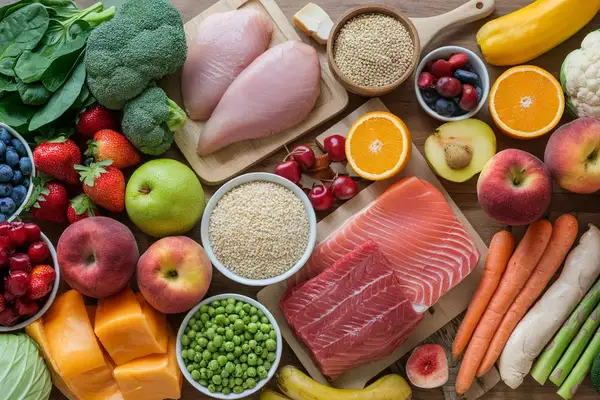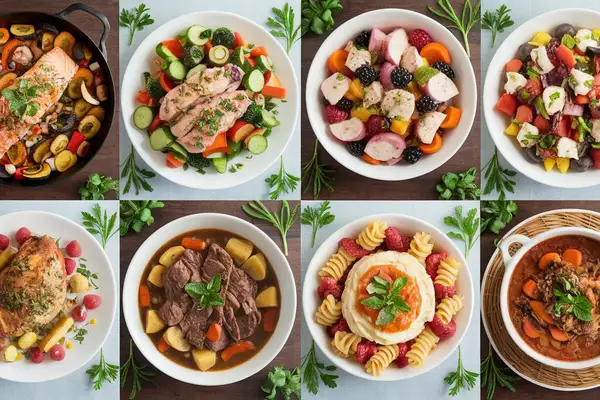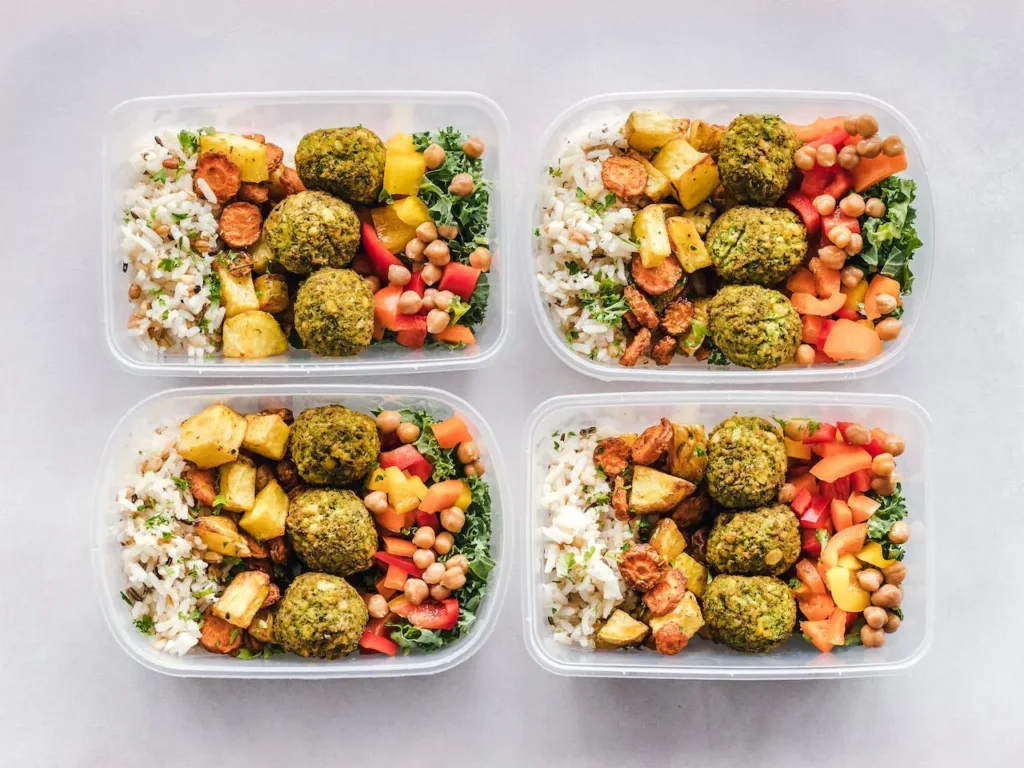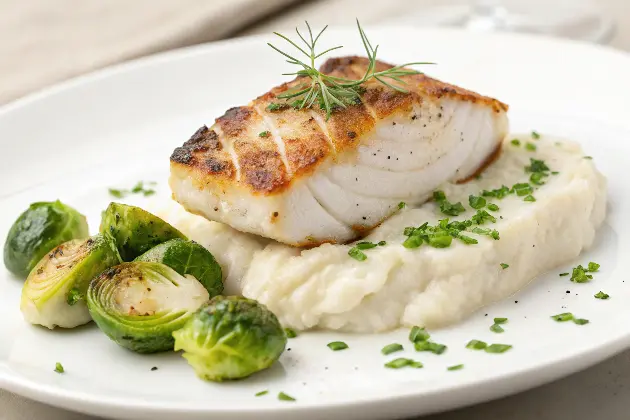Free 7-Day MIND Diet Meal Plan | Brain Healthy Foods
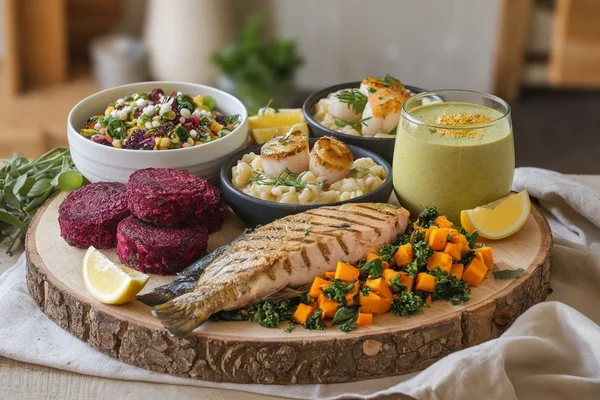
This post may contain affiliate links, meaning I may earn a commission if you make a purchase, at no extra cost to you. I only recommend products I trust. Thank you for your support.
If you’re looking for a diet that not only supports your physical health but also nurtures your brain, the MIND Diet might just be the solution you’ve been searching for.
Designed with brain health in mind, the MIND diet merges the best of the Mediterranean and DASH diets. Its main goal? To reduce the risk of Alzheimer’s disease and support overall cognitive function.
Don’t worry if you’re new to this, we’ll break it down in a way that’s easy to digest (pun intended!). So, grab a cup of green tea (spoiler: it’s great for your brain) and we get started.
Let’s dive into this beginner 7-day MIND diet plan, a breakdown of the MIND diet food list, foods to avoid on the MIND diet, and simple MIND diet recipes that prioritize brain health.
What is the MIND Diet?
First things first, let’s talk about what the MIND diet actually is. MIND stands for Mediterranean-DASH Intervention for Neurodegenerative Delay.
Phew, that’s a mouthful! But don’t let the fancy name intimidate you. Essentially, it’s a diet that combines two well known, heart healthy diets: the Mediterranean diet and the DASH (Dietary Approaches to Stop Hypertension) diet.
The MIND diet was developed by researchers at Rush University Medical Center in Chicago. Their goal?
To create a diet specifically aimed at reducing the risk of dementia and the decline in brain health that often occurs as we age. And let me tell you, the results have been pretty impressive!
The MIND Diet Food List
Before we jump into our 7-day MIND diet meal plan, let’s get familiar with the stars of the show; the foods that make up the MIND diet.
Here’s a detailed list of foods allowed on the MIND diet:
1. Vegetables (6+ servings/week)
- Leafy Greens: Spinach, kale, collard greens, Swiss chard, arugula, romaine lettuce, mustard greens, dandelion greens
- Other Vegetables: Broccoli, cauliflower, Brussels sprouts, bell peppers, carrots, zucchini, asparagus, green beans, eggplant, tomatoes, squash
- Cruciferous Vegetables: Cabbage, bok choy, radishes
- Allium Vegetables: Onions, garlic, leeks
2. Berries (At least 2 servings per week)
- Blueberries: Rich in antioxidants, specifically anthocyanins
- Strawberries: High in vitamin C and manganese
- Raspberries: Good source of dietary fiber and vitamin C
- Blackberries: Packed with vitamins C and K
- Cranberries: Low in calories and high in vitamin C
3. Whole Grains (Aim for 3 servings daily)
- Oats: Rolled oats, steel-cut oats, oatmeal
- Quinoa: A complete protein, rich in fiber, and complex carbohydrate for supplying oxygen to the brain
- Brown Rice: A healthier alternative to white rice
- Whole Wheat (100%): Whole wheat bread, whole wheat pasta, whole wheat flour
- Barley: High in fiber and complex carbohydrate providing energy to the brainy
- Bulgur: Great source of plant-based protein and fiber
- Farro: Nutty flavor, rich in protein and fiber
4. Nuts (Aim for 5 servings per week)
- Almonds: High in healthy fats, fiber, protein, magnesium, and vitamin E
- Walnuts: High in omega-3 fatty acids
- Pistachios: Good source of protein, fiber, and antioxidants
- Cashews: High in healthy fats and plant-based protein
- Hazelnuts: High in vitamins and minerals
- Pecans: Good source of magnesium, calcium, and fiber
5. Legumes (4+ meals/week)
- Beans: Black beans, kidney beans, navy beans, pinto beans
- Lentils: Green, red, brown, and black lentils
- Chickpeas: Also known as garbanzo beans, rich in protein and fiber
- Peas: Green peas, split peas
- Soybeans: Edamame, tofu, tempeh
6. Fish (1+ meal/week)
- Fatty Fish: Salmon, mackerel, sardines, trout, white fish
- Lean Fish: Cod, haddock, tilapia, sole
- Shellfish: Shrimp, scallops, oysters
7. Poultry (2+ meals/week)
- Chicken: Skinless chicken breast, thighs, drumsticks
- Eggs: Source of protein and vitamin B2, B12, iron, choline, and tryptophan which help reduce depression and anxiety.
- Turkey: Ground turkey, turkey breast, turkey tenderloin
8. Healthy Fats
- Olive Oil: Extra virgin olive oil should be used as the primary cooking oil
- Avocados: Fresh avocado, avocado oil
- Nuts and Seeds: Flaxseed, chia seeds, sunflower seeds, pumpkin seeds
- Fatty Fish: Salmon, mackerel, sardines
9. Dairy (In Moderation)
- Low-Fat Dairy: Greek yogurt, low-fat milk, cottage cheese (Limit to about 1 cup per day)
- Cheese: Feta, mozzarella, cheddar, part-skim cheese varieties (Limit to less than 1 serving per week)
10. Herbs and Spices
- Fresh Herbs: Basil, parsley, cilantro, mint, rosemary, thyme
- Spices: Turmeric, black pepper, cinnamon, cumin, oregano
11. Beverages
- Water: The primary beverage of choice
- Green Tea: Rich in antioxidants
- Herbal Teas: Chamomile, peppermint, hibiscus
- Coffee: In moderation, without added sugars or creamers
- Red Wine: Up to one glass per day (optional)
12. Snacks
- Dark Chocolate: 70% cacao or higher
- Nut Butters: Almond butter, peanut butter (natural, without added sugar)
- Popcorn: Air-popped, without added butter or salt
- Fruit Smoothies: Made with berries, Greek yogurt, and spinach
Foods to Avoid on the MIND Diet
Now, I hate to be the bearer of bad news, but consumption of certain foods may negatively impact brain health.
Here’s a detailed list of foods to limit or avoid on the MIND diet:
1. Red Meats
- Processed Meats: Bacon, sausages, hot dogs, deli meats, pepperoni, salami
- High-Fat Cuts: Ribeye, T-bone steaks, fatty cuts of pork and lamb
- Ground Meats: Ground beef, ground pork (especially those with high-fat content)
- Organ Meats: Liver, kidney, brain (due to high cholesterol content)
2. Butter and Margarine (less than 1 tbsp/day)
- Butter: High-fat butter, salted butter, clarified butter (ghee)
- Margarine: Stick margarine, hydrogenated margarine, spreads with trans fats
- Shortening: Used in baking and frying, often high in trans fats
3. Full-Fat Dairy
- Whole Milk: Full-fat milk, cream, half-and-half
- Full-Fat Cheese: Cheddar, brie, blue cheese, cream cheese
- Full-Fat Yogurt: Flavored yogurts with added sugars, full-fat Greek yogurt
- Ice Cream: Especially those high in saturated fats and sugars
4. Pastries and Sweets (less than 5 servings/week)
- Baked Goods: Cookies, cakes, pastries, muffins, doughnuts
- Candies: Chocolate bars (except dark chocolate with high cacao content), gummies, hard candies
- Sugary Snacks: Granola bars with added sugars, sweetened cereals, frosted snacks
- Desserts: Pies, cupcakes, brownies, ice cream sundaes
5. Fried and Fast Foods (less than 1 serving/week)
- Fried Foods: French fries, fried chicken, onion rings, fried fish, fried dough
- Fast Food Meals: Burgers, tacos, fried chicken sandwiches, pizza
- Processed Snacks: Potato chips, cheese puffs, fried snacks, microwave popcorn with butter
- Frozen Foods: Frozen dinners, frozen pizzas, breaded fish sticks
6. Refined Grains
- White Bread: White sandwich bread, white rolls, bagels
- Refined Pasta: Regular pasta, white noodles, instant noodles
- White Rice: Instant rice, white rice products
- Baked Goods: Cakes, pastries, cookies made with refined flour
- Crackers: Saltines, buttery crackers, flavored crackers with refined flour
7. Sugary Beverages
- Sodas: Regular sodas, colas, energy drinks with added sugars
- Sweetened Coffee Drinks: Lattes, frappuccinos, coffee with flavored syrups
- Sweetened Teas: Bottled sweet teas, iced teas with added sugars
- Fruit Juices: Fruit drinks, fruit punches, smoothies with added sugars
- Alcoholic Beverages: Limit to no more than 1 glass of wine per day; avoid sugary cocktails, beer, and spirits with mixers
8. High-Sodium Foods
- Canned Soups: Especially those with added sodium and preservatives
- Processed Meats: Canned meats, deli meats, salted and smoked meats
- Packaged Foods: Instant noodles, pre-packaged rice and pasta dishes, boxed mixes
- Sauces and Condiments: Soy sauce, barbecue sauce, ketchup, salad dressings with high sodium content
9. Trans Fats and Hydrogenated Oils
- Partially Hydrogenated Oils: Found in many processed foods, baked goods, and snacks
- Commercially Baked Goods: Cakes, cookies, pie crusts, crackers made with trans fats
- Fried Foods: Foods fried in hydrogenated oils or with added trans fats
- Margarine and Shortening: Stick margarine, vegetable shortening, some spreads
10. Highly Processed Foods
- Snack Foods: Packaged cookies, chips, snack cakes
- Instant Meals: Boxed mac and cheese, instant noodles, pre-packaged dinners
- Processed Meats: Frozen sausages, hot dogs, deli slices with preservatives
- Sugary Breakfast Cereals: Cereals with added sugars and refined grains
7-Day MIND Diet Meal Plan
This 7-Day MIND Diet Meal Plan is designed to nourish your brain with delicious, nutrient-packed brain boosting foods and meals that support cognitive health.
This MIND diet menu plan will help you get started but feel free to mix and match or adjust portions based on your needs. The key is to include a variety of brain boosting foods throughout the week.
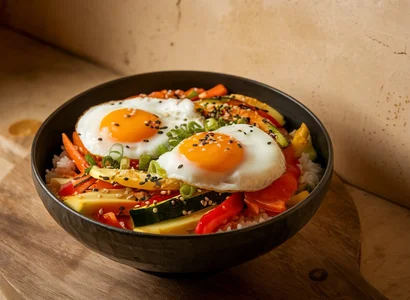
Day 1
Breakfast:
- Sardines & Watercress on Toast: Toast whole grain bread and top with sardines and fresh watercress. Drizzle with olive oil for extra flavor. (1 slice whole grain bread, 3 oz sardines, ¼ cup watercress, 1 tsp olive oil)
Lunch:
- Chicken & Avocado Salad with Blueberry Balsamic Dressing: Toss grilled chicken, avocado, and mixed greens with a balsamic blueberry dressing. (6 oz grilled chicken, ½ avocado, 2 cups mixed greens, 1 tbsp balsamic vinegar, ¼ cup blueberries)
Dinner:
- Bibimbap: Serve brown rice topped with sautéed spinach, mushrooms, kimchi, and a soft-boiled egg. (½ cup brown rice, 1 cup spinach, ½ cup mushrooms, ¼ cup kimchi, 1 egg)
Snacks:
- Warm Olives with Artichoke Hearts: Gently warm olives and artichoke hearts in olive oil with a touch of garlic. (¼ cup olives, ½ cup artichoke hearts, 1 tbsp olive oil)
- Almonds: Enjoy a small handful of almonds. (1/4 cup almonds)
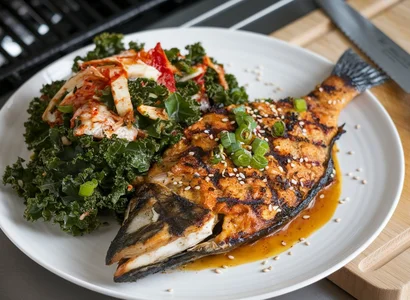
Day 2
Breakfast:
- Pear & Blueberry Breakfast Bowl: Slice pear and mix with blueberries, Greek yogurt, and a sprinkle of flaxseeds. (1 pear, ¼ cup blueberries, ½ cup Greek yogurt, 1 tsp flaxseeds)
Lunch:
- Lentil Soup with Mixed Green Salad: Cook lentils with vegetables in broth. Serve with a mixed green salad on the side. (1 cup lentils, 2 cups mixed greens, 4 cups vegetable broth)
- Carrot, Ginger, and Leek Soup: Blend cooked carrots, ginger, and leeks into a smooth, warming soup. (1 cup carrots, 1 tsp ginger, ½ cup leeks)
Dinner:
- Tikka-Style Fish: Marinate white fish in yogurt and tikka spices, then grill and serve with a side of steamed spinach. (6 oz white fish, ½ cup yogurt, 1 tsp tikka spices, 1 cup spinach)
- Kale Kimchi Salad: Toss kale with homemade kimchi, sesame oil, and pumpkin seeds. (2 cups kale, ½ cup kimchi, 1 tsp sesame oil, 1 tbsp pumpkin seeds)
Snacks:
- Dark Chocolate: Indulge in a small piece of dark chocolate, which contains flavonoids for brain health. (1 oz dark chocolate)
- Berries: Enjoy a cup of mixed fresh berries for a sweet, brain-healthy snack. (1 cup mixed berries)
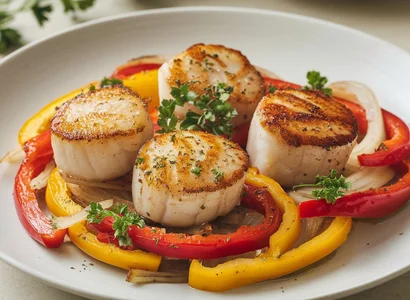
Day 3
Breakfast:
- Salmon, Egg, and Avocado Breakfast Tacos: Fill whole grain tortillas with scrambled eggs, smoked salmon, and sliced avocado. (2 eggs, 2 oz smoked salmon, ½ avocado, 2 small whole grain tortillas)
Lunch:
- Tuna Sandwich: Make a tuna salad with olive oil and lemon, and serve on whole grain bread. (1 can tuna, 1 tbsp olive oil, 1 slice whole grain bread)
Dinner:
- Pan-Seared Scallops with Peppers and Onions: Sear scallops in olive oil and serve with sautéed peppers and onions. (6 oz scallops, 1 cup peppers, ½ cup onions, 1 tbsp olive oil)
- Stir-Fried Tofu with Vegetables: Stir-fry tofu with mixed vegetables. Serve over brown rice. (1 cup tofu, 2 cups mixed vegetables, 1 cup brown rice)
Snacks:
- Blackberry-Basil Sangria: Combine blackberries and basil in sparkling water for a refreshing drink. (¼ cup blackberries, 2 basil leaves, 1 cup sparkling water)
- Apple with Almond Butter: Slice an apple and spread almond butter on each slice. (1 apple, 2 tbsp almond butter)
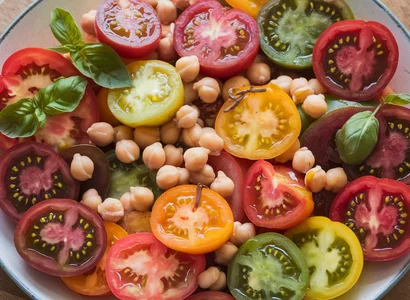
Day 4
Breakfast:
- Whole Grain Pancakes with Sweet Blueberry Compote: Make pancakes with whole grain flour and top with a blueberry compote. (1 cup whole grain flour, ½ cup blueberries, 1 tbsp honey)
Lunch:
- Heirloom Tomato Salad with Chickpeas: Toss heirloom tomatoes with chickpeas, olive oil, and a dash of sea salt. (1 cup tomatoes, ½ cup chickpeas, 1 tbsp olive oil)
Dinner:
- Sheet Pan Salmon and Sweet Potatoes: Roast salmon and sweet potatoes on a sheet pan with olive oil and herbs. (6 oz salmon, 1 cup sweet potatoes, 1 tbsp olive oil)
Snacks:
- Olives and Cheese: Snack on a few olives with a small portion of cheese for a combination of healthy fats and protein. (10 olives, 1 oz feta or cheddar cheese)
- Cucumber Slices with Greek Yogurt Dip: Serve cucumber slices with a Greek yogurt dip for a refreshing snack. (1/2 cucumber, 1/4 cup Greek yogurt)
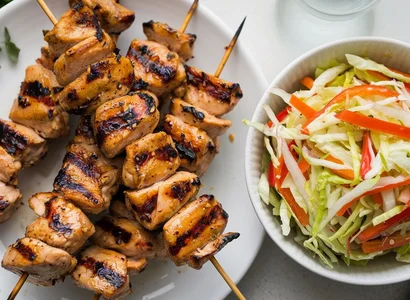
Day 5
Breakfast:
- Pear & Almond Overnight Oats: Soak oats overnight with almond milk, and stir in sliced pear and almonds before serving. (½ cup oats, 1 cup almond milk, ½ pear, 1 tbsp almonds)
Lunch:
- Grilled Chicken Spiedies Skewers: Marinate chicken in olive oil, garlic, and lemon juice, then grill on skewers. (6 oz chicken breast, 1 tbsp olive oil, 1 tsp garlic, 1 tbsp lemon juice)
- Asian Veggie Slaw: Shred cabbage, carrots, and bell peppers, and toss with a sesame vinaigrette. (1 cup cabbage, 1 cup carrots, 1 cup bell peppers, 1 tbsp sesame oil)
Dinner:
- Grilled Trout with Sweet Potato and Kale: Grill trout and serve with roasted sweet potato and steamed kale. (1 trout fillet, 1 sweet potato, 1 cup kale)
Snacks:
- Edamame: Steam edamame and sprinkle with sea salt for a nutrient-rich, satisfying snack. (1 cup edamame, shelled)
- Hard-Boiled Eggs: Enjoy a hard-boiled egg sprinkled with black pepper for a quick, protein-rich option. (1 hard-boiled egg)
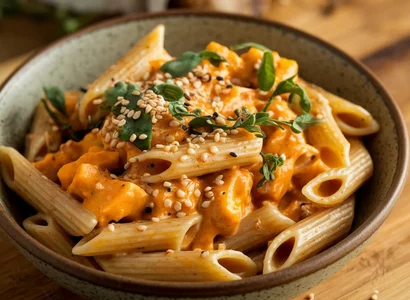
Day 6
Breakfast:
- Turmeric Smoothie Bowl: Blend frozen mango, banana, turmeric, and almond milk, and top with chia seeds and sliced almonds. (1 cup frozen mango, ½ banana, 1 tsp turmeric, 1 cup almond milk, 1 tbsp chia seeds)
Lunch:
- Cauliflower Risotto with Seared Scallops: Cook cauliflower rice with vegetable broth until creamy, and top with seared scallops. (1 cup cauliflower rice, ½ cup vegetable broth, 6 oz scallops)
Dinner:
- Whole Grain Penne with Creamy Squash and Sesame: Cook whole grain penne and toss with a creamy butternut squash sauce and sesame seeds. (1 cup whole grain penne, ½ cup butternut squash, 1 tbsp sesame seeds)
- Zoodle Stir-Fry: Stir-fry zucchini noodles with spinach, mushrooms, and a drizzle of sesame oil. (1 cup zucchini noodles, 1 cup spinach, ½ cup mushrooms, 1 tsp sesame oil)
Snacks:
- Bell Peppers with Guacamole: Slice bell peppers and serve with guacamole. (1 bell pepper, 1/4 cup guacamole)
- Mixed Nuts: A handful of mixed nuts, including almonds and walnuts, for a filling snack. (¼ cup mixed nuts)
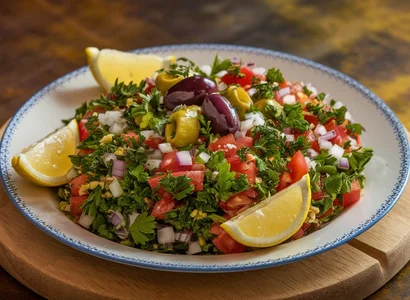
Day 7
Breakfast:
- Wild Blueberry Smoothie: Blend wild blueberries, spinach, almond milk, and a tablespoon of flaxseeds. (½ cup wild blueberries, 1 cup spinach, 1 cup almond milk, 1 tbsp flaxseeds)
Lunch:
- Turkish Tabbouleh: Mix bulgur wheat with fresh parsley, mint, tomatoes, and lemon juice. Serve with grilled chicken. (½ cup bulgur, 1 cup parsley, ½ cup mint, 1 cup tomatoes, 1 tbsp lemon juice)
Dinner:
- Beetroot Patties: Form cooked beets and quinoa into patties and pan-fry with olive oil. Serve with mixed greens. (1 cup cooked beets, ½ cup quinoa, 1 tbsp olive oil, 1 cup mixed greens)
- One-Pan Chicken and Brown Rice: Sear chicken thighs and cook with brown rice, tomatoes, and spices in one pan. (6 oz chicken thighs, ½ cup brown rice, 1 cup tomatoes, 1 tbsp olive oil)
Snacks:
- Apple Slices with Almond Butter: Fresh apple slices dipped in almond butter for a tasty, brain friendly snack. (1 apple, 2 tbsp almond butter)
- Pistachios: Enjoy a small handful of pistachios. (1/4 cup pistachios)
Mind Diet Benefits
Now that we’ve covered what to eat, let’s talk about why the MIND diet is so great for your brain.
Here are some of the key benefits of the MIND diet:
- Reduced risk of Alzheimer’s: Studies have shown that following the MIND diet can lower the risk of Alzheimer’s disease by up to 53%!
- Slower cognitive decline: Even if you don’t follow the diet perfectly, moderate adherence has been associated with a slower rate of cognitive decline.
- Better overall brain health: The nutrients in MIND diet foods support brain function, potentially improving memory and cognitive skills.
- Heart health: Many of the foods in the MIND diet are also great for your heart, which in turn supports brain health.
- Reduced inflammation: Many MIND diet foods have anti inflammatory properties, which can benefit overall health, including brain health.
Cons of the MIND Diet
While the MIND diet has numerous benefits, it’s important to consider potential drawbacks:
- Restrictive for some: If you’re used to eating a lot of red meat or processed foods, the MIND diet might feel limiting at first.
- Potential for nutrient deficiencies: If not properly planned, you might miss out on certain nutrients. For example, if you’re not a fan of fish, you’ll need to find other sources of omega-3 fatty acids.
- Cost: Some of the recommended foods, like berries and nuts, can be expensive, especially when out of season.
- Time-consuming: Preparing fresh, whole foods can take more time than grabbing processed or fast food.
MIND Diet for Beginners: Tips for Success
Starting any new diet can be challenging, but don’t worry, here are some tips to help you succeed on your MIND diet journey:
- Start small: Don’t try to overhaul your entire diet overnight. Begin by incorporating one or two MIND diet foods into your daily meals.
- Plan ahead: Meal planning can help you ensure you’re getting a good balance of MIND diet foods throughout the week.
- Stock up: Keep your pantry and fridge stocked with MIND diet staples like nuts, whole grains, and frozen berries.
- Be flexible: Remember, it’s about overall patterns, not perfection. If you slip up, don’t beat yourself up, just get back on track with your next meal.
- Get creative: Experiment with new MIND diet recipes to keep things interesting. There are countless delicious ways to prepare MIND diet foods!
- Stay hydrated: While not specifically part of the MIND diet, staying well-hydrated is crucial for overall health, including brain function.
- Combine with exercise: For maximum brain benefits, pair your MIND diet with regular physical activity.
Wrapping Up
And there you have it folks, your comprehensive guide to the MIND diet!
Remember, this isn’t just a diet; it’s a lifestyle change that can have profound effects on your brain health.
The best part? Many of these MIND diet foods are delicious and versatile, so you don’t have to feel like you’re sacrificing taste for health.
As with any significant dietary change, it’s always a good idea to consult with your healthcare provider or a registered dietitian before starting, especially if you have any existing health conditions or concerns.
The journey to better brain health is a marathon, not a sprint. Be patient with yourself, celebrate small victories, and remember that every MIND diet-friendly meal you eat is a step towards a healthier brain.
So, are you ready to give your brain some love? Why not start with that berry-licious smoothie for breakfast tomorrow?
Here’s to your health, your happiness, and your incredibly resilient and amazing brain. Cheers!
- Best meal plan for type 2 diabetes
- Bland foods for upset stomach BRAT diet
- 2 weeks zero sugar diet menu plan
- 7-day oatmeal diet for weight loss
- High protein low calorie meals
- Simple diet to lower triglycerides
- 21 day Fix diet meal plan
- Clean eating dinner recipes
- The military diet plan
- Metabolic confusion diet for women
- 7-day endomorph diet plan
- How to cure anemia with diet
- 7-day apple cider vinegar cleanse instructions
- Bone healthy recipes for bone density
FAQs
Can I eat eggs on the MIND diet?
Yes, you can eat eggs on the MIND diet. They are a good source of protein and important nutrients like choline, which supports brain health. Aim for up to 3-4 eggs per week as part of a balanced diet.
Can you eat chocolate on the MIND diet?
Dark chocolate (70% cocoa or higher) can be consumed in moderation on the MIND diet. It contains flavonoids that may benefit brain health. Limit intake to 1-2 small squares a few times a week.
Is milk allowed on the MIND diet?
While not specifically recommended, low-fat milk can be included in moderation on the MIND diet. Consider plant-based dairy alternatives like unsweetened almond or soy milk for better alignment with MIND diet principles.
Can you eat tofu on the MIND diet?
Yes, tofu is an excellent food choice for the MIND diet. It’s a plant-based protein source that can replace red meat in meals.
Tofu is rich in isoflavones, which may have protective effects on brain health. Include it 1-2 times per week as part of a varied diet.
How many eggs a day for brain health?
For brain health, consuming 1 egg per day is sufficient and generally considered safe.
What is the super food for the brain?
Blueberries are often considered the top superfood for brain health. They’re rich in antioxidants and have been linked to improved memory and cognitive function.
What drink improves memory?
Green tea is known to improve memory and cognitive function thanks to its high levels of antioxidants, caffeine, and L-theanine, which can enhance brain function.
Disclaimer: This MIND diet meal plan is for informational purposes only and should not replace professional medical advice. Always consult with a healthcare provider or registered dietitian before making significant changes to your diet.
